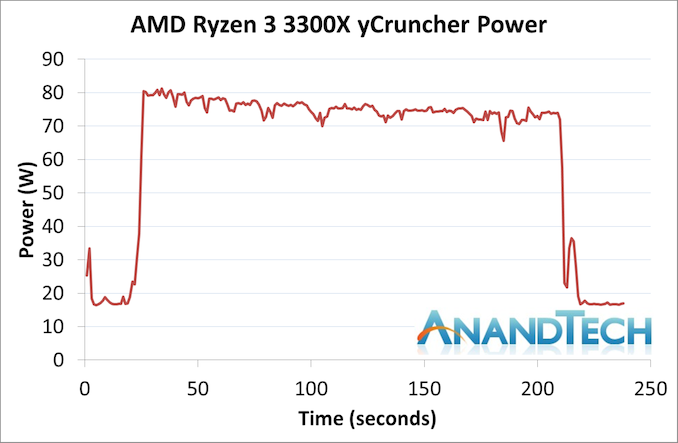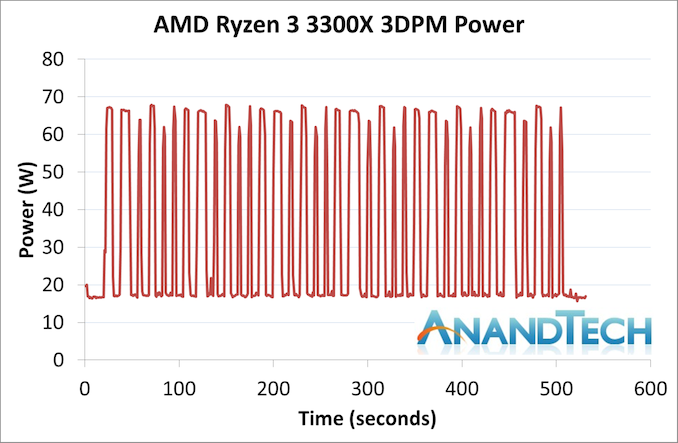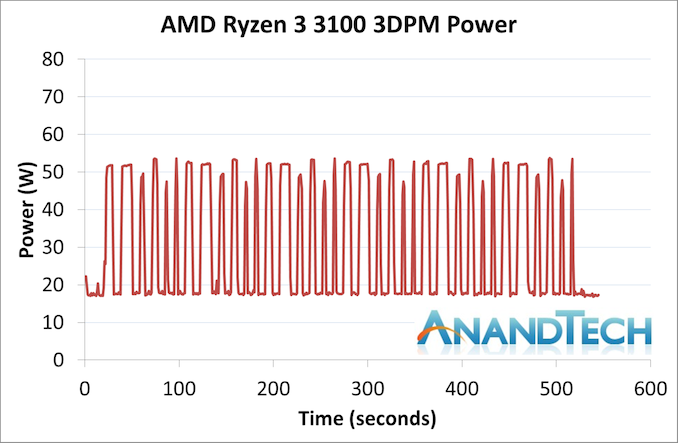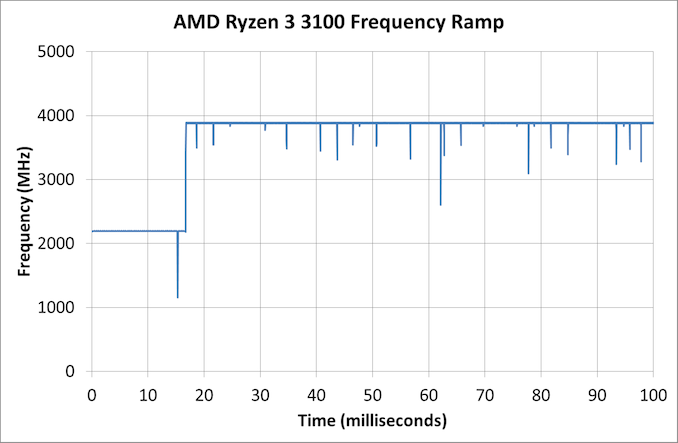The AMD Ryzen 3 3300X and 3100 CPU Review: A Budget Gaming Bonanza
by Dr. Ian Cutress on May 7, 2020 9:00 AM ESTPower Consumption and Frequency Ramps
On the box, both processors are listed as having 65 W TDPs. With its Zen-based hardware, AMD has been relatively good at staying around that official on-the-box value, even during turbo. In the last generation, AMD introduced a feature called PPT, or Package Power Tracking.
- For 105 W processors, PPT is >142 W
- For 65 W processors, PPT is >88 W
- For 45 W processors, PPT is >60W
This allows the processor to raise its power limits, assuming it isn’t breaching thermal limits or current limits, and consequently raise the frequency. As a result, while we see 65 W on the box, the real world power consumption during most tasks is likely to be nearer 88 W, unless the current or thermal lines are crossed.
As a new element to our testing, we are recording power over a number of benchmarks in our suite, rather than just a simple peak power test.
AMD Ryzen 3 3300X
For the faster chip, we saw a peak power in both of our tests of around 80 W.
With yCruncher, which is somewhat of a periodic load, the power consumption dropped over time to nearer 75 W.
3DPM is more obvious with its idle steps between loads, being 10 seconds on then 10 seconds waiting. The power almost peaked at a similar amount here.
In both of these graphs, the package power when idle is around 16-17 W. I looked back through the data, and noticed that out of this power only 0.3 W was actually dedicated to cores, with the rest being towards the big IO die, the memory controllers, and the Infinity Fabric. That’s still pretty substantial for an idle load.
At low loads, the power per core was around 14 W, while at full load it was slightly less depending on the test. This is a bit away from the 20 W per core we get from the high end Zen 2 processors, but these only go to 4.3 GHz, not 4.7 GHz+. This is about in line with what we expect.
On our frequency ramp test, the Ryzen 3300X went from an idle state to peak power within 17 milliseconds, or approximately a frame at 60 Hz.
One of the new features with Ryzen 3000 is CPPC2 support, which AMD claims to reduce idle-to-turbo ramping from 30 milliseconds to 2 milliseconds. We’re seeing something in the middle of that, despite having all the updates applied. That being said, the jump up to the peak frequency (we measured 4350 MHz, +50 MHz over the turbo on the box) is effectively immediate with zero skew across a range of frequencies.
AMD Ryzen 3 3100
Given that the TDP number on the side of the box says 65 W as well, any reasonable user would assume that the power of this chip would be equal, right? Regular readers will know that this isn’t always the case.
In our yCruncher test, because the turbo frequency is lower than the 3300X, it means the voltage can be lower, and thus power is lower. Our history of testing Zen 2 has shown that these cores get very efficient at lower frequencies, to the point where our processor doesn’t even break that 65 W threshold during yCruncher.
Similarly the 3DPM peaks are also lower, barely going to 55 W during an AVX2 workload.
On the frequency ramp side, we see another instance of a 16-17 ms transition.
Summary
For the peak power out of all of our testing, we saw the Ryzen 3 3300X hit a maximum of 80 W, and the Ryzen 3 3100 go to 62 W. When we compare that to the Core i7-7700K, at 91 W TDP / 95 W peak, combined with most of the results on the next few pages, AMD by comparison is more efficient.
















249 Comments
View All Comments
alufan - Friday, May 8, 2020 - link
just curious if I follow the "bench" link it shows Intel at the top of the stack in the opening page, yet when I choose to look at the actual results with the drop down then the results change, yet the opening page is from a benchmark in which the Thread ripper has not even been tested on, the whole industry recognises that its probably the single fastest chip out there for the HEDT platform yet your opening page shows Intel at the top and no 2020 results, once again this looks like careful manipulation of the results and the casual viewer dropping on the page just sees the top 4 out of 6 positions taken by Intel with TR2 mixed in and no mention of TR3 not a very fair page and it gives a poor impression and a possibly misleading impression to folks who know no better and instantly get the impression Intel sells the highest performing CPUs which we know is not the case anymoreqwertymac93 - Friday, May 8, 2020 - link
There are two versions of "bench" for CPUs. "CPU" & "CPU 2019". You need the 2019 one to see the more recent results.alufan - Saturday, May 9, 2020 - link
and thats what I did clicked the link in the article and ended up with a page showing intel as having all the top spots which we all know is no longer the case...that was my point the opening summary page should reflect the results not the results of 2 years ago, and its now month5 of 2020 not 2019 "latest" results should be 2020zodiacfml - Friday, May 8, 2020 - link
This 3300x is something beats the six core 2600. In some reviews, it is equal to 3600 in games while a slightly behind in rendering tasks. I have already decided that a six-core is minimum for me since the 1600 but this...andrewaggb - Friday, May 8, 2020 - link
It's pretty good for what it is but for a cheap PC, intel has graphics. For a cheap gaming PC it's a bargain now but probably won't age well with 8 core consoles coming out this year. If you can afford the 3700x (or better), that should last 8+ years for gaming.Tchamber - Friday, May 8, 2020 - link
The Ryzen 3 3200G had preside graphics, too.ahenriquedsj - Saturday, May 9, 2020 - link
Good job.Mugur - Saturday, May 9, 2020 - link
Ian, sorry to say this, but you must find another organisation for you. Anandtech is just the ghost of what it was. You need at least what every youtuber has to conduct a decent set of benchmarks. You need to buy cpus, videocards, etc. for decent testbeds when they not sampled to you. I'm sick of seeing obscure outfits with every cpu and gpu possible, while a real expert is using a 1080 etc.Rudde - Saturday, May 9, 2020 - link
Will you update the conclusion to include 3100?lmcd - Saturday, May 9, 2020 - link
That board compatibility diagram must be flawed because my B350 board from ASRock has validated support for everything in the 3XXX series.